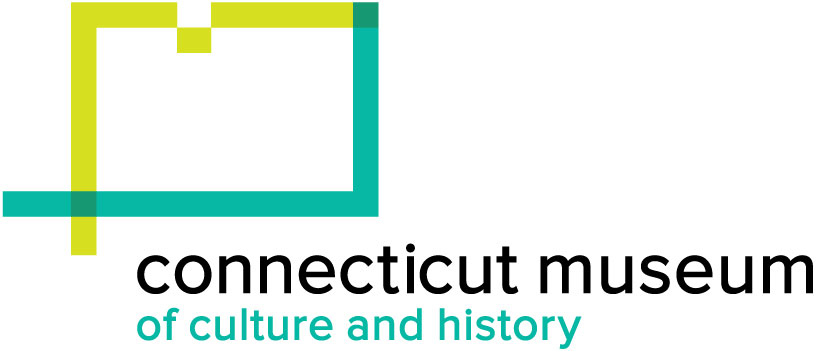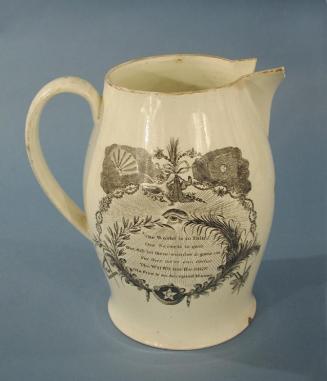Pitcher
MakerMade by
Unknown
Date1795-1810
MediumWheel-thrown cream-colored earthenware with underglaze black decoration and overglaze enamels in green, red, blue, and maroon
DimensionsPrimary Dimensions (height x width x depth): 11 3/8 x 11 x 5 3/4in. (28.9 x 27.9 x 14.6cm)
ClassificationsCeramics
Credit LineGift of the heirs of Morgan B. Brainard
Object number1961.12.35
DescriptionBarrel-shaped pitcher of cream-colored earthenware, a type of ceramic known as creamware. This is known as a "Liverpool pitcher" because many creamware pitchers of this shape with black printed designs were known to have been made and exported to America from Liverpool, England. The pitcher has a flat base, swelled sides, and a narrow, tall rim, with a spout opposite a pulled and applied handle. The pitcher is embellished at the rim with a line of hand-painted, maroon enamel. The handle is embellished with maroon enamel lines, dots, and a flower. There are four transfer-printed underglaze black designs: one on each side, one under the handle, and one under the spout. These have been hand-painted over the glaze with enamels in yellow, green, red, and blue. The first design, to the right of the handle, shows a woman in a yellow dress and three children standing between two Corinthian columns that support a brick or stone arch. An eye floats in the space above the woman's head. Below the design, the following saying is printed "To judge with candor; and to speak no wrong./ The feeble to support against the strong./ To soothe the wretched and the poor to feed./ Will cover many an idle foolish deed." The second design, below the spout, shows three different orders of columns with many Masonic symbols superimposed on the columns or in the space above and between. These symbols include seven stars, a cross, the sun, the moon, the letter "G", a sun dial, measuring and drafting tools, a tent, books, and a small classical building. The third design, to the left of the handle, shows two columns standing on a black and white tile ground. The two columns are wrapped with banners that read "VIDE/ AUDE/ TACE" on the left and "SITLUX/ ETLUX/ FUIT" on the right. A figure of a woman stands at the top of each column. Between the two columns is an eye floating in a dark cloud, along with a sun, moon, and figure of a woman next to an anchor. Below the cloud, several Masonic symbols float in the space between the columns. These include a square and compass, keys, measuring and drafting tools, a sand dial, a beehive, a star, letter "G", and three candles. Also floating in this area are two narrow banners. The one on the left states "MEMENTO" and the on on the right states "MORI". Below the design is the statement "United for the benefit of Mankind". This entire design is flanked by vines and plants which have been hand-painted in green and red enamel. The fourth and final design is located beneath the handle. The small, circular design shows a sun and five-pointed star flanked by two columns; each column supports a globe. Several Masonic symbols fill the space around the columns including a square and compass, letter "G", pyramid, moon, and cross. This area is surrounded by a border of abstract geometric shapes and a few additional Masonic symbols, including two keys. The exterior surfaces of the pitcher are scratched. There are four hairline cracks in the body of the pitcher to the upper right of the handle. The bottom of the pitcher also has several cracks that are surrounded by a light brown discoloration in the ceramic.
Status
Not on view














